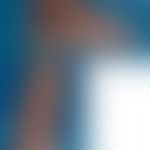Synonym(s)
HistoryThis section has been translated automatically.
DefinitionThis section has been translated automatically.
Sexually transmitted infectious disease(STI) caused by Haemophilus ducreyi, which is rare in industrialized countries and no longer subject to mandatory reporting, with prevalence mainly in tropical-subtropical regions and major European cities and port cities.
Non-venereal ulcerative Haemophilus ducreyi infections also occur in tropical countries (see Fig.).
You might also be interested in
PathogenThis section has been translated automatically.
Haemophilus ducreyi is a gram-negative, coccoid, non-motile, non-spore-forming bacterium of the genus Haemophilus to which another 15 human pathogens (e.g. Haemophilus influenzae) belong.
EtiopathogenesisThis section has been translated automatically.
Transmission of H. ducreyi by sexual intercourse or smear infection after contact with skin lesions in already infected persons.
LocalizationThis section has been translated automatically.
ClinicThis section has been translated automatically.
Venereal transmitted Haemophilus ducreyi infection (ulcus molle):
Incubation period: 2-5 days. Initially, kinic papules rapidly disintegrate, with formation of soft, smeary, painful ulcers with undermined margins. Some ulcers heal spontaneously after several weeks without treatment. With progression, formation of unilateral, highly painful regional lymphadenitis. There is a tendency to purulent lymph node meltdown. Not infrequently, fistula formation also follows. Further inoculation of the ulcers to adjacent skin areas (autoinoculation) is possible.
Non-venereally transmitted Haemophilus ducreyi infection (ulcus molle): Haemophilus ducreyi infections of the skin also occur in tropical countries as non-venereally transmitted painful, chronic ulcers. Apparently, children are more frequently affected than adults (van Hattem JM et al. 2018; see Fign).
Special forms:
DiagnosisThis section has been translated automatically.
Microscopic (Gram or Unna-Pappenheim stain: reddish rods in fish train-like arrangement) and cultural (GC-HgS medium or Mueller-Hinton HB agar) pathogen detection. PCR detection!
Reminder. Repeated control of syphilis serology!
Differential diagnosisThis section has been translated automatically.
Ulcus durum; Ulcus mixtum; Lymphogranuloma inguinale; Granuloma inguinale; Herpes genitalis.
In non-venereal Haemophilus ducreyi infections of the skin, numerous chroic ulcers of other etiologies may be considered.
External therapyThis section has been translated automatically.
Notice! Surgical lymph node incision is usually not necessary!
Internal therapyThis section has been translated automatically.
Systemic antibiosis, see Table 1 / p.a. p. 17 of the current guidelines of the STI Society
Azithromycin 1.5 - 2 g p.o. once (therapy failure in HIV+ and HSV- concomitant infection with azithromycin 1.0 g three times more frequently)
Alternative: Ceftriaxone 500 mg i.m. once only
Reminder. Control and, if necessary, treatment of the sexual partner is required, even if he or she does not show any symptoms!
Progression/forecastThis section has been translated automatically.
TablesThis section has been translated automatically.
Antibiotic therapy of the ulcer molle
Active substance |
Example preparations |
Dosage |
|
Medium 1st choice |
Azithromycin |
Zithromax |
Single dose: 1000 mg p.o. |
Erythromycin |
Erythrocin Filmtbl., Eryhexal Kps., Erythromycin Wolff Filmtbl. |
4 times 500 mg/day p.o. over 7 days |
|
| |||
Alternatively |
Ceftriaxone |
Rocephin |
0,25 g i.m. as single dose |
| |||
With simultaneous HIV infection |
Ciprofloxacin |
Ciprobay Filmtbl. |
2 times 500 mg/day p.o. over 3-5 days |
Amoxicillin/Clavulanic acid |
Augmentan Filmtbl. |
500/125 mg/day p.o. over 3-5 days |
|
LiteratureThis section has been translated automatically.
- Dt. Gesellschaft zur Bekämpfung der Geschlechtskrankheiten (1992) Richtlinien zur Diagnostik und Therapie von sexuell übertragbaren Krankheiten.
- Ducrey A (1889) Il virus dell'ulcera venerea. Gazz Internaz Med Chir (Naples) 11: 44.
- Ducrey A (1889) Experimental investigations on the infectious agent of soft chancre and on the bubones. Monatsh prakt Dermatol 9: 387-405
- González-Beiras C et al.(2016) Epidemiology of Haemophilus ducreyi infections. Emerg Infect Dis 22:1-8.
- Kaur C et al (2002) Erythema nodosum induced by chancroid. Sex Transm Infect 78: 388-389.
- Korting HC et al (1989) Diagnosis and therapy of molle's ulcer today. Dermatologist 40: 418-422
- Krefting R (1892) Ueber die für ulcus molle specifische Mikrobe. Arch Dermatol Syphil (Berlin) 2nd supplement: 41-62
- Kyriakis KP et al (2003) Incidence determinants of gonorrhea, chlamydial genital infection, syphilis and chancroid in attendees at a sexually transmitted disease clinic in Athens, Greece. Int J Dermatol 42: 876-881
- Lewis DA (2003) Chancroid: clinical manifestations, diagnosis, and management. Sex Transm Infect 79: 68-71
- Steen R (2001) Eradicating chancroid. Bull World Health Organ 79: 818-826
- van Hattem JM et al (2018) Haemophilus ducreyi cutaneous ulcer contracted at Seram Island, Indonesia, presented in the Netherlands. PLoS Negl Trop Dis 12:e0006273.
Incoming links (28)
Acutal ulcer; Anal fissure; Chancre; Chancrelle; Chancre mou; Chancroéde; Chancroid; Ducrey-unna disease; Enoxacin; Erythromycin; ... Show allOutgoing links (20)
Azithromycin; Ceftriaxone; Donovanosis; Fusidic acid; Haemophilus; Papel; Polihexanide; Potassium permanganate; Povidone-iodine; Sti; ... Show allDisclaimer
Please ask your physician for a reliable diagnosis. This website is only meant as a reference.










